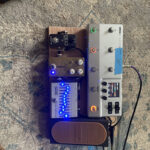Guitar sizes can vary significantly, from the incredibly petite ukulele to the booming jumbo acoustic. Understanding these size differences is crucial, especially for beginners or players with specific needs. This guide will walk you through various guitar sizes, from the smallest to the largest, helping you identify the ideal fit for your playing style and physical comfort.
Guitar Sizes – The Tiniest Option: Ukulele
The ukulele, originating from Hawaii, is a four-stringed instrument that is smaller than a standard guitar. It stands out as the smallest “guitar-like” instrument you’re likely to encounter.
Ukuleles are particularly well-suited for individuals who find regular guitars too cumbersome. This includes young children, adults with smaller hands, or anyone who appreciates the ukulele’s bright, cheerful sound and its lightweight, portable nature.
The ukulele produces a distinctly bright, trebly tone, lacking the deep bass frequencies of larger guitars.
It’s also important to note that ukuleles are tuned differently from standard guitars. This can be a consideration for beginners who plan to transition to a full-sized guitar later, as it requires learning new chord shapes and finger positions eventually.
Guitar Sizes – The Baby Guitar: Guitarlele
The guitarlele, sometimes referred to as a kiku, might initially resemble a ukulele, but it’s slightly larger and features six strings, like a standard guitar. It firmly holds its place among the smallest guitar sizes available.
It effectively bridges the gap between the portability of a ukulele and the versatility of a traditional guitar. This makes it an excellent choice for players who desire both qualities, particularly those concerned about guitar sizes due to travel or space constraints.
A significant advantage of the guitarlele is that it uses the same chord shapes as a standard guitar.
This is a major benefit, and why guitarleles are often recommended over ukuleles, especially for those aiming to learn guitar in the future.
Guitarleles are tuned higher than standard guitars, specifically a fourth higher. In terms of key, a guitarlele in standard tuning is equivalent to a standard guitar with a capo placed on the 5th fret.
This higher tuning can sometimes lead to confusion when a guitarlele player attempts to play alongside a standard guitar, as the pitches will differ.
Similar to ukuleles, guitarleles have a bright, trebly tone profile. Their sound is quite similar in character to a ukulele, but with the added range and harmonic complexity of six strings.
Are you new to guitar and looking for the right instrument to start with? Explore our article: What’s The Best Beginner Guitar?
Guitar Sizes – Half the Size: Half-Size Guitar
The half-size guitar, as its name clearly indicates, is designed to be half the size of a standard, full-scale guitar!
Among the various guitar sizes, the half-size is exceptionally popular for young children who would find a full-sized guitar too large and unwieldy to manage comfortably.
Both electric and acoustic guitars are manufactured in half-size versions, offering choices for different styles of play.
Unlike the guitarlele which has a higher tuning, a half-size guitar is tuned to concert pitch, which is the same as standard guitar tuning. This is a significant advantage for learning standard guitar techniques and songs.
Half-size guitars are perfectly suited for younger children, but as children grow in size and strength, they will eventually need to transition to larger guitar sizes.
Generally, around the age of 8, children typically begin to outgrow half-size guitars and benefit from moving to a slightly larger instrument. This next step up in guitar sizes is often a…
Guitar Sizes – For Growing Players: Three-Quarter Size Guitar
The three-quarter size guitar represents the next increment in size, and of all guitar sizes, this is generally considered ideal for children aged approximately 8 to 12 years old.
However, it’s important to note that three-quarter size guitars aren’t exclusively for children. They are also an excellent option for adults who are petite in stature or who simply prefer a more compact and comfortable instrument.
Similar to half-size guitars, both electric and acoustic guitars are available in three-quarter sizes, catering to varied musical preferences.
While both acoustic and electric three-quarter size guitars will share a similar overall length, the body of an electric guitar will typically be thinner. This is because electric guitars rely on electronic pickups and amplifiers for sound projection, rather than the resonant hollow body of an acoustic guitar.
Guitar Sizes – Compact Adult Choice: Parlor Guitar
The parlor guitar is recognized as the smallest of the full-scale guitars. This guitar size is particularly appealing to guitarists transitioning from a three-quarter size to a full-size instrument.
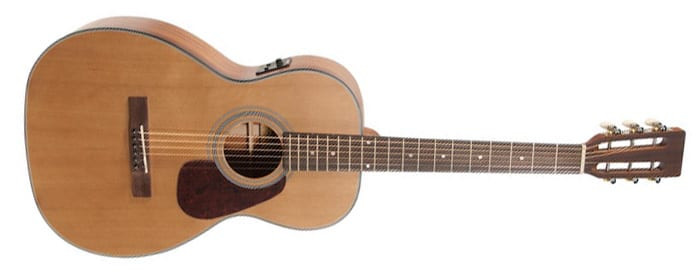 Parlor guitar leaning against a wall
Parlor guitar leaning against a wall
Parlor guitars are also a great choice for players who find larger guitar types like Jumbos and Dreadnoughts too bulky or awkward to handle.
Anecdotally, many women find parlor-sized guitars to be particularly comfortable and enjoyable. They sit comfortably on the lap, produce a pleasing tone, and are generally very accessible and playable.
Among the various guitar sizes, the parlor guitar is known for its rich mid-range sound. This contrasts with the boomy, bass-heavy sound of jumbo guitars or the brighter, trebly sound of smaller instruments.
Join over 100,000 guitarists and receive world-class guitar tips & tutorials directly to your inbox: Click here to subscribe
Guitar Sizes – Big Sound, Medium Body: Auditorium Guitar
Auditorium guitars are similar in overall size to Dreadnoughts, but they feature a curvier and often thinner body profile. This design can make them a bit more comfortable to hold and play, especially when seated.
We are now moving into the realm of larger guitar sizes. Auditorium guitars produce a full, deep, and bass-rich sound thanks to their substantial lower body bout. However, their curvier shape often allows them to sit more comfortably on the player’s knee compared to some other large-bodied guitars.
These guitars are a good fit for players who desire a powerful sound but may not want the absolute largest guitar body. They offer a balance of volume, tone, and comfortable playability.
Guitar Sizes – The Classic Acoustic: Dreadnought Guitar
The Dreadnought guitar, as its powerful name suggests, is a large guitar designed to produce a big, resonant sound. It is arguably the most iconic and “classic” of all guitar sizes.
The large, voluminous body of a Dreadnought allows for significant sound reverberation within the instrument. This results in a strong bass response and overall powerful projection, making it a favorite for genres like bluegrass, folk, and rock.
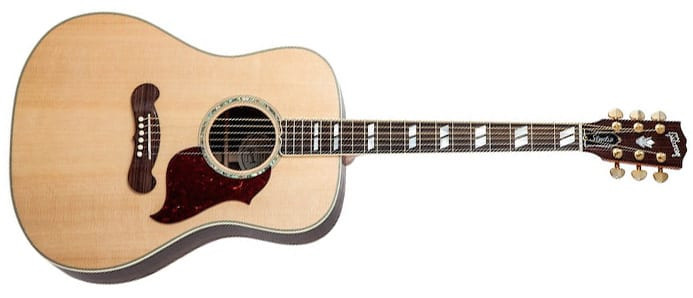 Dreadnought guitar on a stand
Dreadnought guitar on a stand
If you don’t mind the larger body size and appreciate the full, powerful sound that comes with it, then a Dreadnought might be the perfect acoustic guitar for you.
However, it’s worth noting that the Dreadnought’s size can be less comfortable for smaller individuals or those who prefer a guitar with a more pronounced mid-range or treble emphasis.
Guitar Sizes – The Largest Acoustic: Jumbo Guitar
The Jumbo guitar is another large-bodied instrument designed for a big, expansive sound. It represents the largest of the common acoustic guitar sizes and is known for its warm, powerful tone.
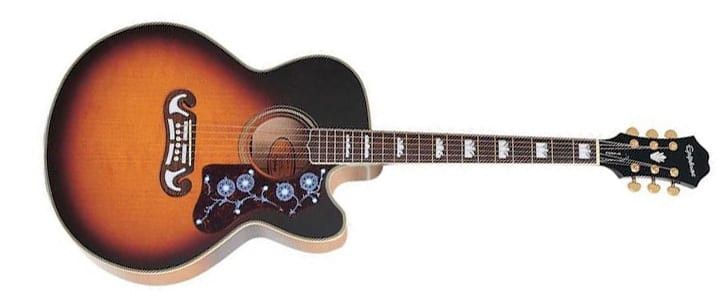 Jumbo guitar in natural finish
Jumbo guitar in natural finish
Generally, a larger guitar body equates to a bigger sound. However, it also means a bulkier instrument that can be less convenient to transport and hold while playing, especially for extended periods.
Larger individuals often find that bigger guitars like Jumbos are a comfortable fit, although this is not a strict rule. Ultimately, the best way to determine if a Jumbo is right for you is to try playing one yourself before making a purchase.
Sometimes, the allure of the Jumbo’s massive sound is enough to persuade even smaller guitarists to adapt to the larger body size.
Guitar Sizes – Electric Full-Size Guitars
The electric guitar market offers a vast array of models and styles. However, unlike acoustic guitars, electric guitar sizes don’t typically vary as widely beyond half-size, three-quarter-size, and full-size options.
This limited variation in size is primarily because electric guitars generate sound through electronic pickups and amplifiers, rather than relying on the resonance of a hollow body. Electric guitars usually have a solid body.
Consequently, there aren’t direct electric guitar equivalents to acoustic guitar sizes like Parlor, Auditorium, Dreadnought, or Jumbo. Instead, the primary size considerations are generally full-size electric guitars.
As mentioned earlier, electric guitars typically feature thinner bodies compared to acoustics. Therefore, a full-size electric guitar, while sharing a similar overall length to a full-size acoustic, will generally have a smaller body profile.
It’s important to note that while electric guitars tend to be more compact in body size, they can also be surprisingly heavy. This is due to their solid body construction, often made from dense woods like mahogany or ash.
Guitar Sizes – The Low End: Bass Guitars
While this guide mainly focuses on standard guitar sizes, it’s worthwhile to briefly touch upon bass guitar sizes as well.
The Fender Precision Bass is perhaps the most iconic and recognizable bass guitar, and it’s known for being a substantial, full-sized instrument.
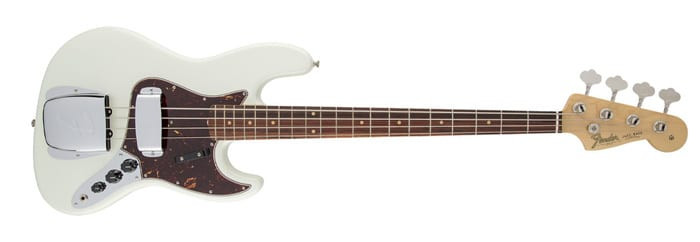 Bass guitar with a dark finish
Bass guitar with a dark finish
However, smaller bass guitar sizes do exist. Notably, Paul McCartney famously played a Hofner Violin Bass, which featured a smaller, rounded body shape.
Similar to standard guitars, bass guitars are also available in half, three-quarter, and full-size versions, catering to players of different ages and sizes.
There is even a ukulele-sized version of the bass, known as a bass ukulele or ukulele bass, offering an even more compact option for bass players.
Finding the right guitar size is a personal journey. Consider your body size, playing style, and desired sound to discover the perfect fit for you and your musical aspirations.

